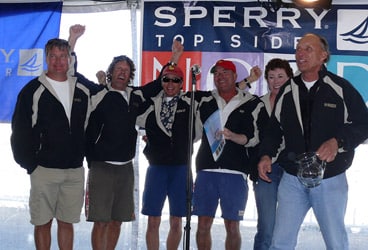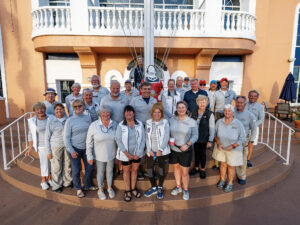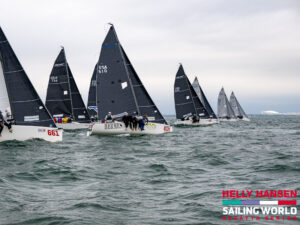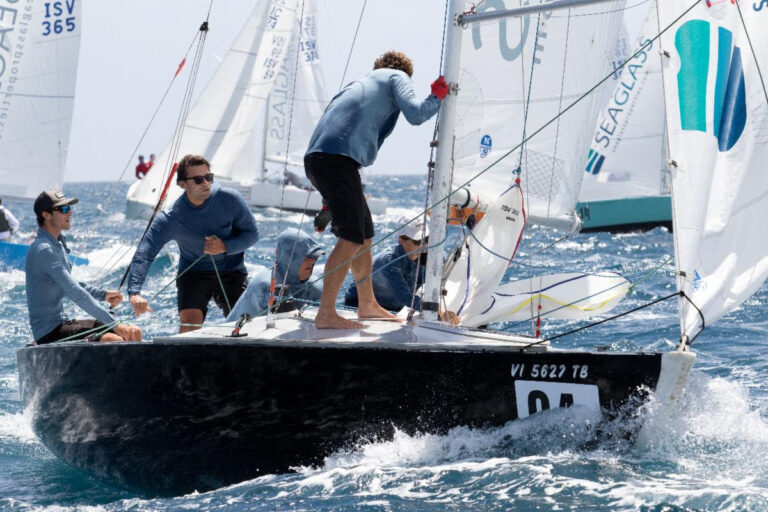Dennis and Sharon Case don’t exactly agree on the secret to retaining good crew. But they certainly agree on its value. “People fail to understand that [sailing] is really a team sport like basketball,” says Dennis Case, a semi-retired real estate investor from San Diego who took the overall win at the 2009 Sperry Top-Sider San Diego NOOD Regatta in his J/105 Wings.
The Cases have been sailing together since before they were married 22 years ago. Jim Dorsey and Dave Loysen, main and spinnaker trim, respectively, joined the team 16 years ago. Bob Capita and Dan Aeling round out this crack crew, which handled Saturday’s light and shifty conditions just as smoothly as it did Sunday’s big waves and gusts to 24 knots.
In November the Cases will have the opportunity to test their skills against the overall champions from the other eight NOOD regattas at the 2009 NOOD Caribbean Rendezvous. Sunsail provides each team with a Sunsail 39 to race and cruise throughout the British Virgin Islands. Last year’s winners from San Diego, Will Stout and his Etchells team set the bar high last November, winning the racing on the water, and the partying both on and off the water.

Stuart Streuli| |Dennis and Sharon Case (far right) have had plenty of succss in the J/105 class, due in no small part to consistent, long-term crew.| After presenting Case and his team with their award, we corralled Dennis and Sharon and got them to divulge a few of their secrets.
Sailing World: How long have you been in the class?
Dennis Case: We have been in the class since 2002. We chartered a boat in the NOOD in 2001 to see if we liked it, and we won. So we decided we liked the boat and we’ve proceeded now to win in five times out of eight.
SW: That’s an impressive track record.
DC: Yes. Just between you and me I think we like the stronger breezes and that always comes with the NOOD a little bit of extra breeze. We’ve got a good crew and when you’ve got a good crew that shows when it gets a little more demanding.
SW: Tell us a little bit about your crew?
DC: Jim Dorsey and Dave Loysen have been with us for 16 years, my main trimmer and my spinnaker trimmer. So they’ve been with us in the Schock 35 fleet and through the 105. In the Schock fleet we won three national championships and four high-point championships, we had a good time there. The other guys are fairly new to our crew. Bob Capita has been with us three years, and Dan [Aeling], this is his first year.
SW: When someone is “fairly new” and he’s been sailing with you for three years, you’re obviously winning the crew-retention game.
DC: People fail to understand that it’s really a team sport just like basketball and it’s amazing when you can depend upon your other crewmembers and you know they’re going to perform in a particular way. We’ve been around the marks just about every possible way you can go around the mark and they’re always with me and I have the confidence knowing they can handle the situation and that makes a lot of difference as far as the skipper’s concerned. I can bring the boat in sideways and it still gets around.
SW: You mentioned that you like the breeze, but three of the five races were sailed in light and shifty conditions on Saturday. You had a first, a second, and a fourth. What were you doing right then?
DC: Sometimes it’s luck, you’re in the right place at the right time when it’s shifting. Nobody has a lock on where to be all the time. In one of the races where we were doing not so well and we got a second, we did have an idea where the wind was. On the downwind leg we came around on the left-hand side of the course [looking upwind] and the breeze never came down to us, but we saw it was just a little past us. So when we rounded the leeward mark we took the right gate [looking downwind] to come back on up and see if we could find that and we did and that brought us up about five places.
SW: Seems like a key move, with a short regatta like this you really can’t afford any poor finishes.
DC: You never can afford a bad one. Winning regattas is avoiding the big points, not taking the big risks.
SW: Sharon, tell us about today, gusts to 23 to 24 knots, what was working for you today?
Sharon Case: I wasn’t, I don’t do over 20. I didn’t like that first set when it was blowing 23, 24. We did OK, there were a few roundups next to us and in front of us. The crew settled down and we got the boat moving and it worked well.
SW: Did you set on all five downwind legs today? On the first leg, at least, it was split pretty evenly among the J/105s, with half the fleet going wing-on-wing and half setting spinnakers.
SC: We set every leg, and it worked.
SW: What is the key to keeping a J/105 on its feet when it gets to 20 knots?
DC: As always, travel down and depowering and [jib] lead back. That one jib is an all-purpose jib and it handles us in 7 knots and it handles us in 20 knots. You can imagine we’re way overpowered in 20 knots. So you just have to scantilize it, bring the lead back not just an inch or two, but four or five inches so the jib rolls off at the top, and do the same thing with the main, travel down, and try to keep it on its feet.

Tim Wilkes/www.timwilkes.com|
|Whether it was keeping the boat powered up and moving downwind in light air on Saturday (above) or keeping it on its feet upwing through 25-knot gusts on Sunday, Dennis and Sharon Case’s team on Wings had it down cold.|
SW: What about downwind?
DC: Oh, downwind, you just take is as deep as it can go. Well, deep as it can go most of the time. In these conditions we could surf. If you’re really smart you’d know to click it up about 20 degrees and get into a surfing mode then bring it back down again. On the first one, I don’t know if we were that smart, but when we popped the chute we went into immediate surfing.
SC: Nobody beats us downwind, we have very good boatspeed downwind.
DC: So we were surfing for a quite a bit of that first downwind. We couldn’t believe how short it was. We barely got under control and then we had to jibe and in 20-plus knots we’re not used to sail handling in such conditions-the guys in San Francisco, if they read this, they’re going to think we’re such wimps-but we took it down way early. I’ve raced in San Francisco, they take their chutes down way early and we did the same thing.
SW: Well you can lose a lot more with a bad takedown than you can gain with a late one.
DC: Risk reward. At that point we came around that first weather mark like in sixth position. But with the round-ups and the round-downs and all the chaos that happened, we were in third position and there was a big gap behind us. That’s what I was thinking, I’ll hold on to a third at that point. We worked up to second and that’s where we held.
SW: What about yourselves personally? Are you from San Diego?
DC: She’s pretty much originally from San Diego. I’m from Los Angeles, originally, which is a long time ago. But I’ve been here since 1980.
SW: What do you do for a living?
DC: Well I’m retired. And I retired her when we got married 22 years ago.
SC: So we started racing before we got married and I started racing with him. So I didn’t sail until I met him. I’ve been on every race.
SW: So the marriage has endured 22 years of sailing, or is it the other way around?
SC: All of the above. It’s all been good. We’ve had wonderful success and we’ve had a lot of fun and we’re very blessed.
SW: You mentioned having consistent crew. Most people would do anything for that sort of longevity. What is the key to keeping them around?
DC: A lot of people when I first started, they looked for killer crew that could make you a winner. If you get one of those guys to come out one time, as a favor, you’d be lucky. But they can’t be consistent. What you have to do is fine somebody who has the same interest you do in getting better and working hard at it. If you can find that kind of desire then you can work together and you can all improve together and that’s how you build a team…
SC: No, It’s management. It’s management. You have somebody who is managing the team and it control of the boat. That makes a successful program. If you’re successful, you keep crew. But you have to have a successful management program. Organization, the boat’s prepared, you’ve got the right sails. All of the above. Management starts with the skipper. And that’s where I think our success has come from, a strong skipper and helmsman.
DC: Also boat preparation. There’s another guy with the same initials up here, Dennis Conner, and he said, “No excuse to lose.” That’s an excellent mantra. The guys say your sails aren’t new enough, get some newer sails and then say, “Now where are we losing?” Our rigging’s a little heavy? Get some lighter rigging. “OK, now why are we losing?” Take away all those excuses. Pretty soon you’ve got to perform.









